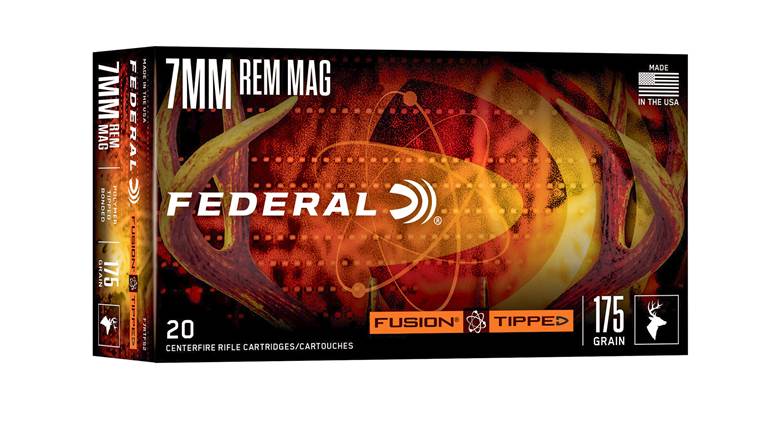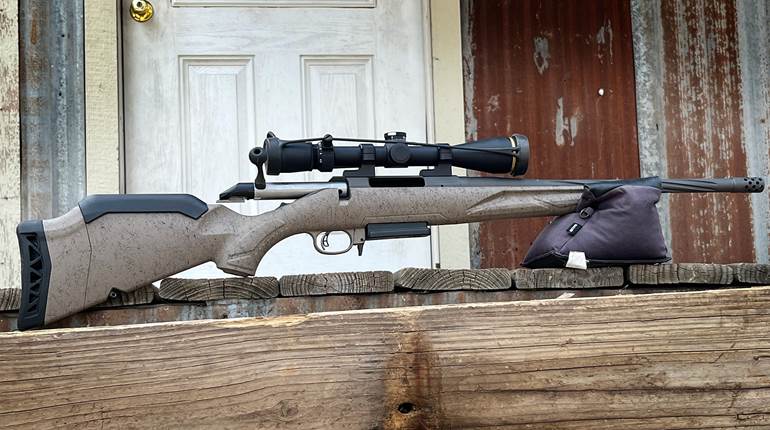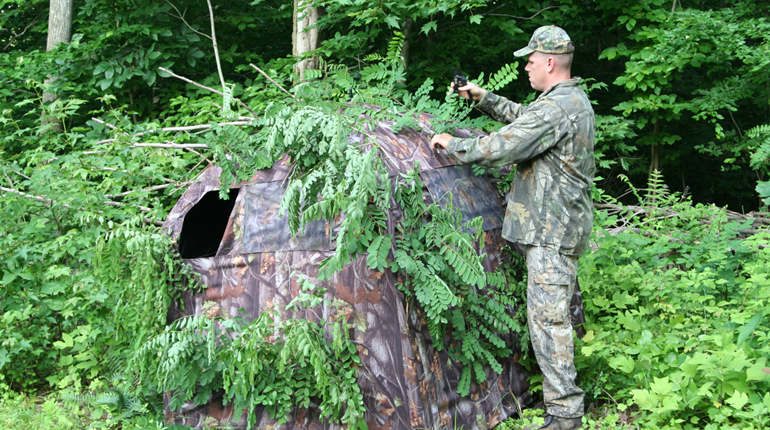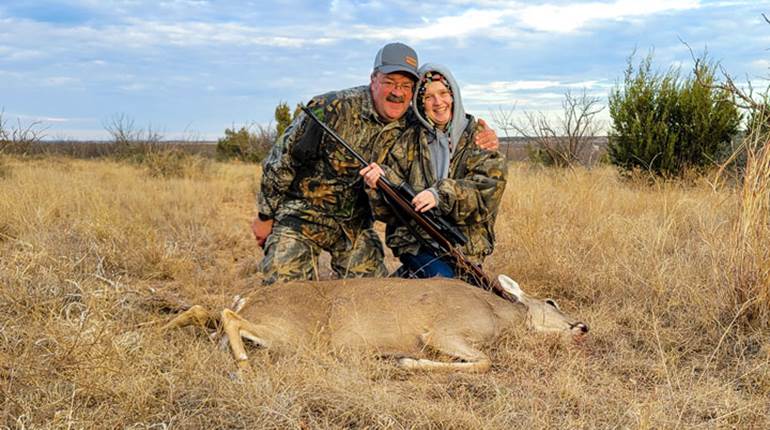
Top: Mossberg’s Patriot Revere goes old school with a figured walnut stock.
Certain rifle cartridges come and stay, while others fade away. The .270 Winchester has been a sought after cartridge since it was introduced way back in 1925.

Only three other cartridges, other than the .270 Win., are loaded with .277-caliber bullets. The 6.8 Rem. does not count as a hunting cartridge. The .270 Weatherby (center) and 270 WSM (left) have not provided much competition to the original .270.
That popularity is somewhat perplexing as the .270 had no initial leg up as a military or target cartridge. Its fame resulted from its use as a hunting cartridge for several reasons. For one, bolt-action rifles were coming into wide-spread acceptance for hunting in the years after the .270 was introduced. That action was best for the .270 to handle its high maximum average pressure of 65,000 psi that generates, even today, some spectacular velocities. Bolt-action rifles are generally fairly light, too, something hiking hunters appreciate. Acceptance begets acceptance, and the .270 is always in mind when new factory ammunition or reloading components are introduced.
A lightweight .270, like this custom rifle based on a Winchester Model 70 action, is a hiking hunter’s friend.
Popularity
When I started hunting as a boy, the .30-06 Spr. and .30-30 Win. were about the only rifles my uncles and their friends carried while hunting. Once I left the mountain valley to go down river to attend college, I met several fellows with .270 rifles stored in their dorm room closets. The .270 cartridges I handled certainly looked fast just sitting in my hand. I went shooting and hunting with these classmates shooting their .270s. Their rifles knocked over black bears and deer just as well as my ’06. The .270 bullets did seem to shoot flatter than my ‘06’s 180-gr. bullets.
Everywhere, .270s began to appear. Hunters shouldering their backpacks at trailheads were most likely carrying a .270. Whole families carried .270s after game from antelope to elk. My future father-in-law shot a .270 based on an FN Mauser action.
I hunted with the rifle and shot some deer and a big black bear. I walked around the curve in a trail and saw the bear about 30 yards away with its head down mowing grass. It looked up at the click of the rifle’s safety switching off, but the 130-grain bullet was already on its way.
CVA chambers its single-shot Apex in .270, and one of the rifles accounted for this Wyoming mule deer.
This bull elk fell from a shot from a Mossberg .270.
Rifles
The FN weighs a few candy bars over 8 lbs. with its 24” barrel and a straight 4-power scope in steep rings and bases. I eventually bought a lighter Ruger M77. My oldest son took the Ruger when he was 15 and never looked back.
One October on the antelope prairie I sat back and watched Paul stalk an antelope buck. Cover ran out about 275 yards from the buck. The buck started to walk away. Paul sat up with his .270 braced on his knees and fired. The buck pitched over on its nose.
Several other bolt-action .270s have come and gone over the years. A Remington Model 700 Mountain SS that weighs 6.5 lbs. with a thin barrel and aramid-fiber-reinforced stock is one current .270. A Mossberg Patriot Revere is another, with a figured walnut stock reminiscent of the stocks on old Model 70 Winchesters.
If you want a lever-action .270, Browning makes a BLR. Browning also makes a BAR autoloader. Merkel chambers its K3 single-shot in .270 and Remington its 7600 pump. A lot of words could be wasted listing all the bolt-actions chambered in .270. Suffice it to say every, standard-length action rifle is chambered in .270.
Factory Loads
Where to start? Federal alone sells 16 different .270 loads, Hornady 12 and Winchester 10. Include Browning, Fiocchi, Norma, Nosler, Remington, Swift and others and the list grows enormously. Most of these loads include bullets that weigh 130, 140 and 150 grains.
Federal Power*Shok 130-gr. Copper ,270 loads shot this group fired from a Mossberg .270.
A few new .270 loads include, from the left, Browning BXS 130-gr. Solid Expansion, Federal Premium 130-gr. Trophy Copper, Federal Power*Shok 130-gr. Copper, Federal Premium 140-
A sample of regular bullets, with a lead core and copper alloy jacket, include Federal Power٠Shok, Hornady InterLock, Remington Core-Lokts, Winchester Power Points and Sierra GameKings loaded by several companies.
The .270 gained its name as a flat-shooting cartridge. Federal’s Non-Typical Whitetail cartridges are loaded with regular 150-gr. Soft Point bullets. These bullets have a round nose, which look anything but long-range. Federal must have figured most whitetails are shot at short range.
Lead cores bonded to copper alloy jackets include Trophy Bonded Tip bullets loaded by Federal, Nosler AccuBonds and Long Range AccuBonds loaded by Federal and Winchester, Oryx loaded by Norma and Core-Lokt Ultra Bonded bullets loaded in Remington Hypersonic cartridges.
Hunters afflicted with “magnumitis” quote bullet ballistics like passages from the Bible and somehow their figures compiled for the .270 always come up short for hunting elk. However, it’s not bullet energy that kills elk. Elk are killed by placing a proper bullet in the correct place.
This dispute concludes in the .270’s favor as an elk cartridge shooting single-metal copper and copper alloy bullets. Some of these bullets include Barnes Triple-Shocks loaded by Remington, BXS bullets loaded by Browning, Copper and Trophy Copper bullets loaded by Federal and GMX bullets loaded by Hornady.

.270 Handloads
Handloads provide the option to shoot a variety of bullets styles and weights, experiment with propellants to increase bullet speeds over factory ammo and tailor loads to your rifle. 
Propellants on the slow-burning side are suitable for loading 130- to 150-gr. bullets in the .370. H4831has been the .270 propellant for decades. It’s still a good choice. However, in recent years other powders have come along that also provide good accuracy and top velocity. Alliant Reloder 26 is one of them.
Before hunting season opened last fall I handloaded Nosler 150-gr. Partitions with Reloder 26 for my Mossberg Patriot Revere .270. I settled on 59.5 grs. of Reloder 26 that fired the Noslers at 2,968 f.p.s. from the Mossberg’s 24” barrel. An additional grain of Reloder 26 increased velocity to 3,038 f.p.s. But accuracy was better with the lighter amount of powder. That higher velocity sits right on the heels of 7 mm magnum cartridges.
During the season, a whitetail buck dodged back and forth among the willows in a creek bottom. I finally had a shot through a tunnel in the brush and the bullet plowed length-wise clear through the buck. A couple days later I climbed a steep ridge. I spotted a five-point bull bedded down in some short fir trees 200 and some yds. across a draw. All sorts of time was available to set up the rifle on shooting sticks and think about making the shot. I thought too much. The bull finally stood up and I snapped off a shot that hit it high in rear of the neck. It ran and I took another shot when it stopped at 275 yards. The bullet punched through both lungs and out the far side. The bull dropped dead, slid down the hill on the snow and wedged itself between 2 trees.
A couple days later I climbed a steep ridge. I spotted a five-point bull bedded down in some short fir trees 200 and some yds. across a draw. All sorts of time was available to set up the rifle on shooting sticks and think about making the shot. I thought too much. The bull finally stood up and I snapped off a shot that hit it high in rear of the neck. It ran and I took another shot when it stopped at 275 yards. The bullet punched through both lungs and out the far side. The bull dropped dead, slid down the hill on the snow and wedged itself between 2 trees.
Other cartridges, some that have faded and some that have stayed, provide that .270 performance on game. In fact, there are more .26, 7 mm and .30-cal. cartridges than man buns at a craft beer festival. The .270 is so dominant, though, everyone knows what cartridge you’re talking about when you just say “.270.”




































